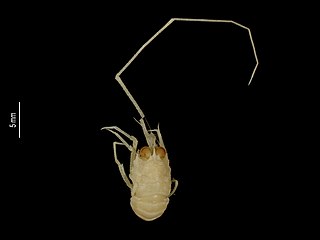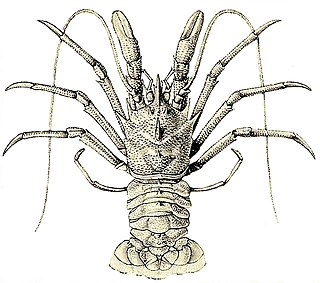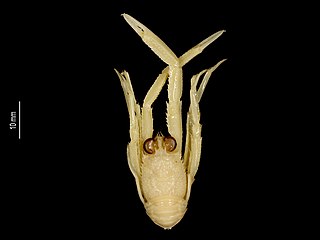
Munidopsis serricornis is a species of squat lobster. It is widely distributed in the world's oceans, being found in the eastern Atlantic Ocean, the western Atlantic Ocean, and the Indo-Pacific. It grows up to a carapace length of 20 millimetres (0.8 in).
Nanogalathea raymondi is a species of squat lobster from the Bay of Bengal. It is the only species in the genus Nanogalathea. It can be distinguished from other squat lobsters by the lack of any teeth along the edge of the rostrum. The specific epithet raymondi commemorates the carcinologist Raymond B. Manning.
Anomoeomunida is a monotypic squat lobster genus in the family Munididae. The sole a species of is Anomoeomunida caribensis. It occurs in the western Atlantic.

Anoplonida is a genus of squat lobsters, which are flattened dorsoventrally, in the family Munididae, containing the following species:

Bathymunida is a genus of squat lobsters in the family Munididae, containing the following species:

Coralliogalathea is a genus of squat lobsters in the family Galatheidae. Initially thought to be monotypic, solely represented by Coralliogalathea humilis, recent analysis has split the genus into six, morphologically similar but genetically different species.

Crosnierita is a genus of squat lobsters in the family Munididae, containing the following species:
Enriquea leviantennata is a species of squat lobster in a monotypic genus in the family Munididae.
Fennerogalathea is a genus of squat lobsters in the family Galatheidae, containing the following species:

Galacantha is a genus of squat lobsters in the family Munidopsidae, containing the following species:

Heteronida is a genus of squat lobsters in the family Munididae. They occur in the western Pacific Ocean.

Lauriea is a genus of squat lobsters in the family Galatheidae, containing the following species:

Leiogalathea is a genus of squat lobsters in the family Munidopsidae, containing the following species:

Neonida grandis is a species of squat lobster in a monotypic genus in the family Munididae.

Onconida is a genus of squat lobsters in the family Munididae, containing the following species:

Plesionida is a genus of squat lobsters in the family Munididae. As of 2017, it contains the following species:

Raymunida is a genus of squat lobsters in the family Munididae, containing the following 11 species:
Setanida cristata is a species of squat lobster in a monotypic genus in the family Munididae.

Shinkaia crosnieri is a species of squat lobster in a monotypic genus in the family Munidopsidae. S. crosnieri lives in deep-sea hydrothermal vent ecosystems, living off of the chemosynthetic activity of certain bacteria living on its setae.
Tasmanida norfolkae is a species of squat lobster in a monotypic genus in the family Munididae.















